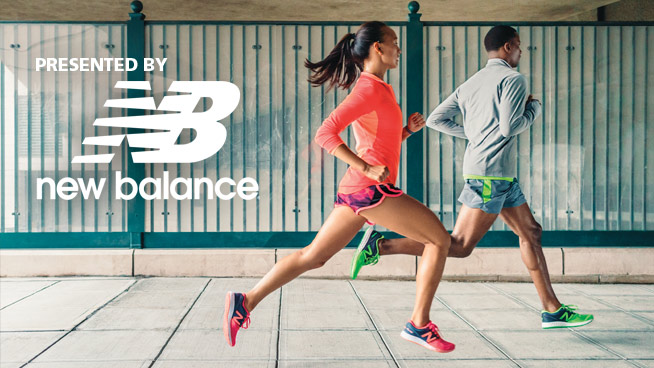
Many runners lace up their shoes and immediately start running. This lets you get right into it, but it may take a toll on your body and cause nagging injuries.
Running without warming up can cause a slew of problems, including muscle pulls, wear and tear on the joints and ligament damage. Such problems might not manifest themselves in a sudden injury. They more typically just gradually wear you down.
That’s where the dynamic warm-up comes into play. A dynamic warm-up prepares your body for activity by increasing body temperature and blood flow, improving range of motion and activating your muscles. Regularly performing a pre-run warm-up like the routine below helps prevent common running injuries such as ankle sprains and pulled hamstrings—and allows you start your run or race at your fastest pace.
The Pre-Run Warm-Up only takes 10 minutes to complete and requires no equipment. Regularly incorporate it into your routine to become a better, more durable runner.
Pre-Run Warm-Up
Jump Rope or Jumping Jacks
Elevates your heart rate and gets blood pumping through your muscles. Both exercises wake up the muscles in your lower legs, which are important for ankle stability.
Sets/Duration: 60 sec.
High Knees
High Knees engage your hip flexors, which play an important role in your stride mechanics.
Sets/Distance: 2×10 yards
Butt Kicks
Butt Kicks activate your hamstrings, one of the primary muscle groups responsible for propelling you forward. The hamstrings are especially susceptible to injury if runners fail to prepare them properly.
Sets/Distance: 2×10 yards
Shuffle
You run straight ahead, but you should be prepared for multi-directional moves. That means activating your lateral hips with the Shuffle.
Sets/Distance: 1×10 yards each direction
Backpedal
On the same note as the Shuffle, the Backpedal activates the muscles on the front of your body, such as your quads.
Sets/Distance: 2×10 yards
Reverse Lunge
Activates your lower-body muscles and opens up your hip flexors, which are often tight due to prolonged sitting.
Sets/Reps: 2×5 each leg
World’s Greatest Stretch
Opens up the muscles in your inner thighs, lengthens your hip flexors and quads, stretches your glutes, and opens up your chest and back. It’s called the Word’s Greatest Stretch for a very good reason.
Sets/Reps: 1×5 each side
Single-Leg Glute Bridge
Your glutes are one of, if not the most important muscles for running. This move activates those large muscles.
Sets/Reps: 1×15 each leg
Plank
Fires up your core muscles so they’re prepared to brace your core and maintain stability during your run. Strong core muscles equates to a more efficient running stride.
Sets/Duration: 1×30 sec.
80 Percent Run
Running at 80 percent of your normal pace is just enough to finish prepping your body for a run without causing fatigue.
Sets/Duration: 1×2 min.
RECOMMENDED FOR YOU
MOST POPULAR

Many runners lace up their shoes and immediately start running. This lets you get right into it, but it may take a toll on your body and cause nagging injuries.
Running without warming up can cause a slew of problems, including muscle pulls, wear and tear on the joints and ligament damage. Such problems might not manifest themselves in a sudden injury. They more typically just gradually wear you down.
That’s where the dynamic warm-up comes into play. A dynamic warm-up prepares your body for activity by increasing body temperature and blood flow, improving range of motion and activating your muscles. Regularly performing a pre-run warm-up like the routine below helps prevent common running injuries such as ankle sprains and pulled hamstrings—and allows you start your run or race at your fastest pace.
The Pre-Run Warm-Up only takes 10 minutes to complete and requires no equipment. Regularly incorporate it into your routine to become a better, more durable runner.
Pre-Run Warm-Up
Jump Rope or Jumping Jacks
Elevates your heart rate and gets blood pumping through your muscles. Both exercises wake up the muscles in your lower legs, which are important for ankle stability.
Sets/Duration: 60 sec.
High Knees
High Knees engage your hip flexors, which play an important role in your stride mechanics.
Sets/Distance: 2×10 yards
Butt Kicks
Butt Kicks activate your hamstrings, one of the primary muscle groups responsible for propelling you forward. The hamstrings are especially susceptible to injury if runners fail to prepare them properly.
Sets/Distance: 2×10 yards
Shuffle
You run straight ahead, but you should be prepared for multi-directional moves. That means activating your lateral hips with the Shuffle.
Sets/Distance: 1×10 yards each direction
Backpedal
On the same note as the Shuffle, the Backpedal activates the muscles on the front of your body, such as your quads.
Sets/Distance: 2×10 yards
Reverse Lunge
Activates your lower-body muscles and opens up your hip flexors, which are often tight due to prolonged sitting.
Sets/Reps: 2×5 each leg
World’s Greatest Stretch
Opens up the muscles in your inner thighs, lengthens your hip flexors and quads, stretches your glutes, and opens up your chest and back. It’s called the Word’s Greatest Stretch for a very good reason.
Sets/Reps: 1×5 each side
Single-Leg Glute Bridge
Your glutes are one of, if not the most important muscles for running. This move activates those large muscles.
Sets/Reps: 1×15 each leg
Plank
Fires up your core muscles so they’re prepared to brace your core and maintain stability during your run. Strong core muscles equates to a more efficient running stride.
Sets/Duration: 1×30 sec.
80 Percent Run
Running at 80 percent of your normal pace is just enough to finish prepping your body for a run without causing fatigue.
Sets/Duration: 1×2 min.











